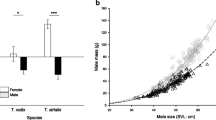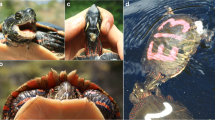Abstract
Cloacal protuberances (CP) in male birds result from spermatic engorgement of storage tubules around the cloaca during the breeding season. We examined seasonal changes in the volume and orientation of the CP in the New Zealand stitchbird Notiomystis cincta. The male stitchbird has one of the largest recorded CPs for any species (max = 1,570 mm3), with CP volume increasing by almost 400% between the non-breeding and breeding seasons. While sperm competition has been positively correlated with the magnitude of CP storage in other species, no evidence previously existed for the CP improving copulation efficiency. By measuring the relative orientation of the CP throughout the year, we show that not only does the CP increase in size as males become sexually active, it also changes its orientation by approximately 60°. This results in it shifting from facing posteriorly to becoming almost perpendicular to the abdomen. This cloacal “erection” improves the apposition of the male and female cloacal openings during face-to-face forced copulation in this species. This provides the first reported evidence supporting the copulation efficiency hypothesis of the avian CP. While the magnitude of seasonal changes in female cloacal volume was similar to males, female cloacal orientation remained virtually unchanged across seasons. This difference between the sexes is likely to reflect differing selection pressures for optimizing sperm transfer. In females, a posterior-facing cloaca is ideal for both waste evacuation and sperm reception, whereas, for the male, a posterior-facing cloaca is well suited for waste evacuation, but possibly hinders sperm delivery. Changes in male cloacal orientation from the non-breeding to the breeding season are a likely reflection of conflict in this dual function. Evidence of changes in CP orientation in another passerine species suggests this phenomenon is widespread and also important for understanding related fields such as sperm competition, forced copulation and constraints on the evolution of the avian intromittent organ.



Similar content being viewed by others
References
Anderson S (1993) Stitchbirds copulate front to front. Notornis 40:14
Birkhead TR, Møller AP (1992) Sperm competition in birds: evolutionary causes and consequences. Academic Press, London
Birkhead TR, Hoi H (1994) Reproductive organs and mating strategies of the bearded tit Panurus biarmicus. Ibis 136:356–360
Birkhead TR, Briskie JV, Møller AP (1993) Male sperm reserves and copulation frequency in birds. Behav Ecol Sociobiol 32:85–93
Briskie JV (1993) Anatomical adaptations to sperm competition in Smith’s longspurs and other polygynandrous passerines. Auk 110:875–888
Briskie JV, Montgomerie R (1997) Sexual selection and the intromittent organ of birds. J Avian Biol 28:73–86
Briskie JV, Montgomerie R (2001) Efficient copulation and the evolutionary loss of the avian intromittent organ. J Avian Biol 32:184–187
Castro I, Minot EO, Fordham RA, Birkhead TR (1996) Polygynandry, face-to-face copulation and sperm competition in the Hihi Notiomystis cincta (Aves: Meliphagidae). Ibis 138:765–771
Castro I, Mason KM, Armstrong DP, Lambert DM (2004) Effect of extra-pair paternity on effective population size in a reintroduced population of the endangered hihi, and potential for behavioral management. Cons Gen 5:381–393
Chiba A, Nakamura M (2002) Female cloacal protuberance of the polygynandrous alpine accentor Prunella collaris: histological features and possible functional significance. Ibis 144:E96–E104
Chiba A, Nakamura M (2003) Anatomical and histophysiological characterization of the male cloacal protuberance of the polygynandrous alpine accentor Prunella collaris. Ibis 145:E83–E93
Cramp S, Perrins CM (1994) Birds of the Western Palearctic, vol 8. Oxford University Press, Oxford
Ewen JG (1998) A genetic and behavioral investigation of extra-pair copulation in stitchbirds (Notiomystis cincta) breeding on Tiritiri Matangi Island. MSc Thesis, Massey University, New Zealand
Ewen JG, Armstrong DP, Lambert DM (1999) Floater males gain reproductive success through extrapair fertilizations in the stitchbird. Anim Behav 58:321–328
Gowaty PA, Buschhaus N (1998) Ultimate causation of aggressive and forced copulation in birds: female resistance, the CODE hypothesis, and social monogamy. Am Zool 38:207–225
Helfenstein F, Wagner RH, Danchin E (2003) Sexual conflict over sperm ejection in monogamous pairs of kittiwakes Rissa tridactyla. Behav Ecol Sociobiol 54:370–376
Higgins PJ, Peter JM, Steele WK (2001) Stitchbird. In: Higgins PJ, Peter JM, Steele WK (eds) Handbook of Australian, New Zealand and Antarctic birds, vol. 5. Oxford University Press, Melbourne, pp 954–966
Hunter FM, Jones IL (1999) The frequency and function of aquatic courtship and copulation in least, crested, whiskered, and parakeet auklets. Condor 101:518–528
Ligon JD (1999) The evolution of avian breeding systems. Oxford University Press, Oxford
Lombardo MP (2001) Individual and seasonal variation in external genitalia of male tree swallows. Auk 118:789–795
Low M (2004) Female weight predicts the timing of forced copulation attempts in stitchbirds, Notiomystis cincta. Anim Behav 68:637–644
Low M (2005) Female resistance and male force: context and patterns of copulation in the New Zealand stitchbird, Notiomystis cincta. J Avian Biol (in press)
McKinney F, Derrickson SR, Mineau P (1983) Forced copulation in waterfowl. Behaviour 86:250–294
Mulder RA, Cockburn A (1993) Sperm competition and the reproductive anatomy of male superb fairy-wrens. Auk 110:588–593
Nakamura M (1990) Cloacal protuberance and copulatory behavior of the alpine accentor (Prunella collaris). Auk 107:284–295
Peer K, Robertson RJ, Kempenaers B (2000) Reproductive anatomy and indices of quality in male tree swallows: the potential reproductive role of floaters. Auk 117:74–81
Salt WR (1954) The structure of the cloacal protuberance of the vesper sparrow (Pooecetes gramineus) and certain other passerine birds. Auk 71:64–73
Thornhill R (1980) Rape in Panorpa scorpionflies and a general rape hypothesis. Anim Behav 28:52–59
Trivers RL (1972) Parental investment and sexual selection. In: Campbell B (ed) Sexual selection and the descent of man 1871–1971. Aldine, Chicago, pp 136–179
Tuttle EM, Pruett-Jones S, Webster MS (1996) Cloacal protuberances and extreme sperm production in Australian fairy-wrens. Proc R Soc Lond B 263:1359–1364
van Valen L (1973) A new evolutionary law. Evol Theory 1:1–30
Wagner RH (1991) Evidence that female razorbills control extra-pair copulations. Behaviour 118:157–169
Wesołowski T (1999) Reduction of phallus in birds—an avian way to safe sex? J Avian Biol 30:483–485
Wolfson A (1952) The cloacal protuberance—a means for determining breeding condition in live male passerines. Bird Banding 23:159–165
Wolfson A (1954) Notes on the cloacal protuberance, seminal vesicles, and a possible copulatory organ in male passerine birds. Bull Chicago Acad Sci 10:1–23
Acknowledgments
We thank Clare Miller, Kirsty Chalmers, Troy Makan and Sandra Jack for help in the field and Barbara Walter, Ray Walter, Ian Price, Thomas-Helmig Christensen, Rachel Curtis, Rosalie Stamp, Richard Griffiths, the Supporters of Tiritiri Matangi Inc and the New Zealand Department of Conservation for logistical support. We also thank Marty Leonard, Staffan Roos and two anonymous referees for their helpful comments on a previous version of this manuscript. This study was supported by a Massey University doctoral scholarship to M.L. and partly funded by the New Zealand Lotteries Commission and the Supporters of Tiritiri Matangi. All work was carried out under a research permit from the New Zealand Department of Conservation, had Massey University animal ethics approval and complied with the current laws of New Zealand
Author information
Authors and Affiliations
Corresponding author
Additional information
Communicated by M. Leonard
Rights and permissions
About this article
Cite this article
Low, M., Castro, I. & Berggren, Å. Cloacal erection promotes vent apposition during forced copulation in the New Zealand stitchbird (hihi): implications for copulation efficiency in other species. Behav Ecol Sociobiol 58, 247–255 (2005). https://doi.org/10.1007/s00265-005-0935-5
Received:
Revised:
Accepted:
Published:
Issue Date:
DOI: https://doi.org/10.1007/s00265-005-0935-5




